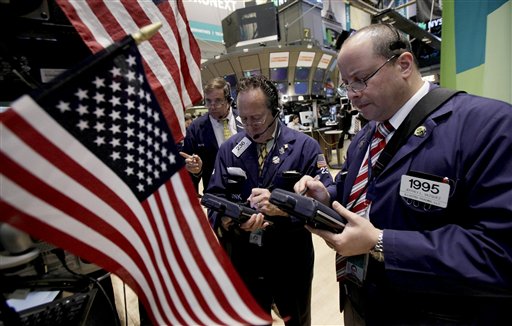By CHRISTINA REXRODE
AP Business Writer
NEW YORK
U.S stocks struggled for direction Wednesday, with the debt maelstrom in Europe as an ominous backdrop.
The major stock indexes opened lower, then briefly turned positive. Shortly before noon, the Dow Jones industrial average and the Standard & Poor’s 500 were down, while the Nasdaq composite index managed to hang on to its gain.
Government borrowing costs rose in Spain and Italy, signaling that investors are worried that those countries might be unable to pay their debt. Across the hobbled continent, uncertainties continued to mount about the Spanish bank bailout, which was announced over the weekend but whose details have not been hammered out.
The Dow Jones industrial average fell as much as 75 points before rising briefly around 10:30 a.m. The gains were short-lived and small, reaching only 17 points. Shortly after noon, the Dow was down 28 points to 12,545.
The Standard & Poor’s 500 index and the Nasdaq composite followed similar patterns. The S&P 500 was down three points to 1,321. The Nasdaq was down five points to 2,838.
Spain’s 10-year borrowing rate inched up to 6.71 percent from 6.67 percent, a day after setting a euro-era record. That is a troubling sign because when the interest rate rises, it means the government is being forced to pay more to persuade investors to buy its bonds. Other countries have had to seek bailouts from their lenders when their borrowing rates hit 7 percent.
Italy, the newest flashpoint in Europe’s debt crisis, had setbacks of its own. Its 10-year borrowing rate rose to 6.11 percent from 6.02 percent the day before, and the country had to pay a sharply higher rate in a sale of 12-month bonds, 3.972 percent versus 2.34 percent a month ago. That augurs poorly for a sale of long-term debt Thursday.
News about the U.S. economy was hard to read. The government said that retail sales fell in both April and May. But excluding gas station sales, where prices dropped throughout those months, retail sales grew modestly in May.
Richard Ross, global technical strategist at Auerbach Grayson in New York, said he’s still bullish on U.S. stocks. He thinks their decline throughout May, which was perhaps a necessary correction, means they’re ready to charge ahead.
Ross thinks the market’s lack of direction this week is a result of investors trading on news headlines rather than examining the fundamentals of individual stocks. “The sovereign debt crisis, the Greek elections, the Egyptian elections _ if you are basing an investment strategy around these headlines, you will be paralyzed,” Ross said.
Slightly less than half of the stocks listed on the New York Stock Exchange rose. Four of the ten major industry indexes in the S&P 500 rose, led by health care.
Big movers included JPMorgan Chase, which rose 68 cents to $34.45 as CEO Jamie Dimon testified to Congress about the bank’s surprise $2 billion trading loss. Dell jumped 44 cents to $12.41 after the computer maker said late Tuesday it would begin paying its first shareholder dividend. Cigarette maker Philip Morris International rose $1.63 to $86.64 after announcing it will buy back more of its own stock.
Scotts Miracle-Gro, which makes lawn-care and plant products, fell $3.18 to $39.87 after issuing weak forecasts for profit and revenue. Cobalt International Energy fell $1.01 after announcing it will abandon a Gulf of Mexico well that hasn’t yielded any commercial hydrocarbons.
The bailout of Spain’s banks was meant to soothe the markets, but the reaction in the U.S. has been inscrutable. U.S. stocks plunged on Monday, then rallied on Tuesday, but that was less about Europe and more about a Federal Reserve leader hinting that the Fed could pump more money into the ailing U.S. economy.
Key details of the bailout have yet to be worked out, including how European leaders would come up with the $125 billion they say they can lend, and how Spain could pay the money back.
The interest rate on the U.S. 10-year Treasury note fell to 1.63 from 1.66 percent. That means investors are moving money into one of the few places where they think it will be safe, with the U.S. government.

COMMENTS
Please let us know if you're having issues with commenting.